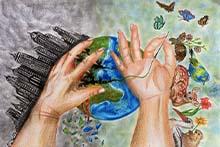Expanding the Narrative of Epidemics
Reflecting on the Early Impact of HIV/AIDS within the South Asian American Community
By Nikhil D. Patil |
FEBRUARY 4, 2021

As we approach this pivotal anniversary and reflect on the legacy of this terrible disease, we can’t celebrate the progress we’ve made without first paying our respects to those who lost their lives to AIDS-related complications. The history of HIV and AIDS in the United States, as it exists today, is often centered around the stories of white, cisgender, gay men. However, this history is replete with omissions. Or rather, historical memory is replete with omissions. The dead can’t tell their stories; they rely on the living, or those who survived, to shape the narrative of the impact of HIV and AIDS in this country. Those whose voices have been ignored or excluded also get left out of our collective memory and are missing from our shared history of the HIV epidemic.
As someone who identifies as a cisgender, bisexual and queer, first generation, Indian American male, I don’t see the diverse stories of my community represented in the history of HIV and AIDS in the United States. These stories exist, and they have value, not only for me, but for others, too. Without these stories, the historical memory is biased and incomplete. Without these stories, we can’t situate our own story within the broader narratives of our community and see where and how we fit in. History, and her-story, and their-story, are a prerequisite to inclusion and belonging. If we want to preserve an inclusive shared history, we must fill those gaps through a participatory approach to documentation, while centering racial, ethnic, and sexual minority voices. The urgency of this work is compounded by the need to hear and preserve these stories before we lose the generation that survived the epidemic.
For my Archival Creators fellowship project, I am collecting oral histories from fellow South Asian Americans and documenting their lived experiences during the early years of the HIV epidemic in the US.3 My work is centered on groups and communities who were most likely to be impacted by the epidemic, namely LGBTQIA+ South Asian Americans and their families, South Asian American frontline healthcare workers, and South Asian American AIDS activists.4 With a focus on the early years of the epidemic, the 1980s and 1990s, I hope to enhance our collective memory about the impact of HIV and AIDS in this country and expand the existing narrative of the epidemic.

In the first phase of my project, I am exploring what already exists in archival collections across the country. I have reached out to libraries and historical centers that host records and documentation of the history of South Asian immigration, queer liberation, and the HIV epidemic in the United States. To identify those who possibly died from an AIDS-related illness, I have searched obituaries and AIDS memorials for South Asian names. I have also listened to existing oral histories, hoping to hear clues of people or organizations relevant to my project. This preliminary probe has uncovered several leads from different disciplines that I am planning to pursue in the upcoming weeks. I hope to create new collaborations and partnerships, while building bridges across archival collections.
As I embark on this next phase of my archival work and begin conducting oral history interviews, I am grateful for the opportunity to preserve this important period of history and add to the existing collective memory of HIV and AIDS in the U.S. through the creation of a new archival collection. I am excited to listen to stories and record memories, and in the process honor the elders of my community. If you have a story to share about the impact of HIV or AIDS on your life or the life of someone you know, please reach out. Let’s find a way to expand the narrative of epidemics together.
1. Centers for Disease Control and Prevention. Pneumocystis pneumonia — Los Angeles. MMWR 1981, 30 (21): 250-252
2. According to the terminology guidelines published in 2015 by the Joint United Nations Programme on HIV/AIDS (UNAIDS), Human Immunodeficiency Virus (HIV) refers to the etiologic or causative agent of AIDS. Acquired Immunodeficiency Syndrome (AIDS) refers to a diagnosed condition that represents the most advanced stage of HIV infection. An AIDS diagnosis requires a viral load test result indicating a CD4 count less than 200 cells/mm3
3. I use “South Asian Americans” as a collective term identifying people whose families originated from the countries of South Asia (India, Pakistan, Bangladesh, Nepal, Sri Lanka, Bhutan, Maldives), including the larger South Asian diaspora
4. LGBTQIA+ is an inclusive abbreviation and a collective term describing the most prevalent gender and sexual minority identities: lesbian, gay, bisexual, transgender, queer or questioning, intersex, and asexual or ally

Nikhil D. Patil, MPH (he/him/his) is a global health researcher working at the intersection of infectious diseases, technology, data, and design. His fellowship project focuses on documenting the lived experiences of South Asian Americans during the beginning of the HIV/AIDS epidemic in the United States, drawing parallels between those early years and the current COVID-19 pandemic. The Archival Creators Fellowship Program is made possible with a grant from The Andrew W. Mellon Foundation.







